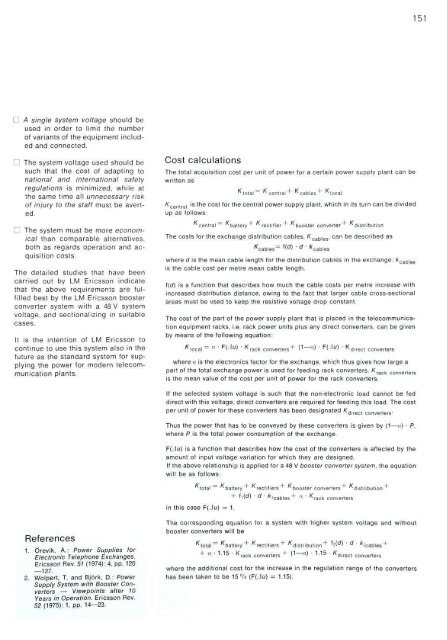geostationary telecommunications satellites electronic telephone set ...
geostationary telecommunications satellites electronic telephone set ...
geostationary telecommunications satellites electronic telephone set ...
Create successful ePaper yourself
Turn your PDF publications into a flip-book with our unique Google optimized e-Paper software.
151<br />
• A single system voltage should be<br />
used in order to limit the number<br />
of variants of the equipment included<br />
and connected.<br />
• The system voltage used should be<br />
such that the cost of adapting to<br />
national and international safety<br />
regulations is minimized, while at<br />
the same time all unnecessary risk<br />
of injury to the staff must be averted.<br />
• The system must be more economical<br />
than comparable alternatives,<br />
both as regards operation and acquisition<br />
costs.<br />
The detailed studies that have been<br />
carried out by LM Ericsson indicate<br />
that the above requirements are fulfilled<br />
best by the LM Ericsson booster<br />
converter system with a 48 V system<br />
voltage, and sectionalizing in suitable<br />
cases.<br />
It is the intention of LM Ericsson to<br />
continue to use this system also in the<br />
future as the standard system for supplying<br />
the power for modern telecommunication<br />
plants.<br />
Cost calculations<br />
The total acquisition cost per unit of power for a certain power supply plant can be<br />
written as<br />
K total = K central" 1 " K cables"*" K local<br />
s tne cost for tne central<br />
^central ' power supply plant, which in its turn can be divided<br />
up as follows:<br />
A central ~ A battery ~ rectifier booster converter "distribution<br />
The costs for the exchange distribution cables, ^cab | es , can '- )e described as<br />
""cables = f ' c '' ' d<br />
' ^cables<br />
where d is the mean cable length for the distribution cables in the exchange; tables<br />
is the cable cost per metre mean cable length.<br />
f(c/) is a function that describes how much the cable costs per metre increase with<br />
increased distribution distance, owing to the fact that larger cable cross-sectional<br />
areas must be used to keep the resistive voltage drop constant.<br />
The cost of the part of the power supply plant that is placed in the telecommunication<br />
equipment racks, i.e. rack power units plus any direct converters, can be given<br />
by means of the following equation:<br />
""local<br />
=<br />
"• '<br />
F (J") ' ""rack converters" 1 " ( 1— -°0 '<br />
F U") '<br />
K direct converters<br />
where a is the <strong>electronic</strong>s factor for the exchange, which thus gives how large a<br />
part of the total exchange power is used for feeding rack converters. K rack converters<br />
is the mean value of the cost per unit of power for the rack converters.<br />
If the selected system voltage is such that the non-<strong>electronic</strong> load cannot be fed<br />
direct with this voltage, direct converters are required for feeding this load. The cost<br />
per unit of power for these converters has been designated K direct converters-<br />
Thus the power that has to be conveyed by these converters is given by (1—r
















